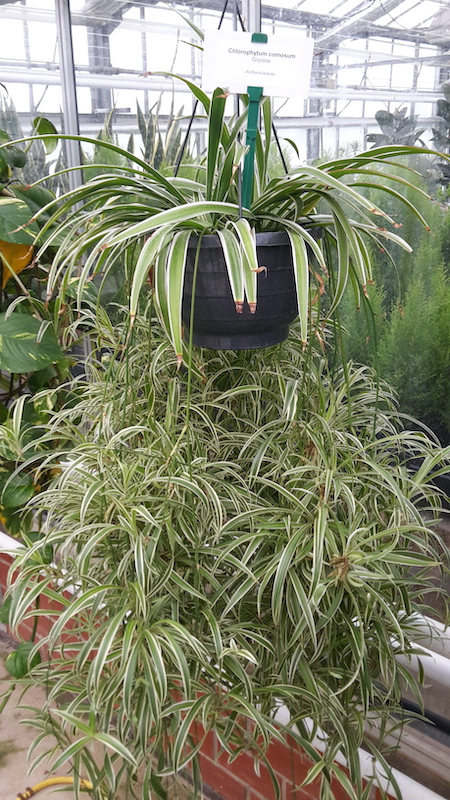As any pet owner knows, it can be difficult to find the right balance between decorating your home and ensuring that your furry friends are safe. But when it comes to plants, there’s one variety of greenery that may provide a purrrfect solution – spider plants! Not only do they look beautiful in homes and gardens, but they’re also non-toxic for cats. So if you’re looking for a plant that won’t pose a risk to the health or safety of your beloved feline friend, then this could be an ideal choice.
Spider plants are non-toxic for cats according the ASPCA. Consuming anything out of the norm can be hard on your cat’s digestion though. If you are concerned, consult a local veterinarian.

Image credit: Florian Wickern; Image licence: CC BY-SA 4.0
What is a Spider Plant?
Spider plants are a type of houseplant that are known for their long, lanky leaves and attractive white and green variegation. They are hearty and easy to grow, making them a popular choice for those looking to bring a bit of greenery into their home. These plants are also considered to be non-toxic for cats, which makes them a great choice for cat owners.
So, what is a spider plant? The plant is native to tropical and subtropical regions of the world, and gets its name from its long, vining stems that look like spider legs. Its leaves are long and narrow, typically variegated in shades of green, white, and sometimes yellow. Spider plants also produce “pups” or baby plants at the end of their long stems, which can be separated and repotted to create a full, lush look.
Caring for a spider plant is fairly easy, as they are quite hardy and resilient. They prefer bright, indirect light and need to be watered regularly. Spider plants can tolerate a wide range of temperatures, making them a great choice for both the office and home. They are known to be non-toxic for cats, but be sure to keep them out of reach of your furry friends, as they can be a choking hazard.
How to Care for a Spider Plant
Taking care of a spider plant is quite simple. First, make sure it is in a pot with draining holes. This will help avoid waterlogging and overwatering the plant. It is best to water the plant once a week and let it dry out in between. Spider plants prefer bright, indirect light, so placing it near a window is a great way to get it the light it needs. You can also use a grow light if you don’t have access to a window.
When it comes to fertilizing your spider plant, a slow-release liquid fertilizer once a month is all it needs. Spider plants are a type of succulent and don’t need a lot of fertilizer to stay healthy. On the other hand, if you see your spider plant getting a bit leggy, you can give it a little more fertilizer.
Spider plants are quite resilient and can handle being root-bound, but if you want to repot it, you should wait until the plant is actively growing in the spring. To repot, simply take the plant out of its current pot, remove any dead or damaged roots and replant it in a slightly bigger pot with fresh potting soil. Make sure to water it thoroughly and keep an eye on it for the first few weeks.
Protecting your plants (and pets)
When it comes to keeping cats from damaging plants, one of the most important steps is to create a safe and structured environment for the cat. This means keeping the cat away from plants, where it can’t knock them over, or use them as a scratching post or chew toy. If the plant is kept in an area the cat has access to you can try to keep it out of reach.
Another tip is to provide plenty of other outlets for the cat’s curiosity. Make sure the cat has plenty of toys to play with, and give it plenty of attention and affection. If cats feel that they are getting enough stimulation, they are less likely to be tempted to damage plants.
Finally, if your cat does start to damage the plants, it’s important not to react with anger or aggression. Instead, try to redirect the cat’s attention away from the plants. If the cat is scratching a plant, try to distract it (but don’t reward it)!
I try to keep something more interesting or appealing near my plants. In the case of scratching, I put quality scratching posts wherever my cats want to scratch – whether that is by the couch or by an indoor tree! DIY or buy one that suits your decor.
Enjoying plants as a cat owner
I love having plants in my home along with my cats. It’s not only aesthetically pleasing to have a variety of vegetation, but I get health benefits from it as well. Plants help to filter the air and can reduce airborne toxins, which helps keep us breathing easier. They regulate humidity. Plus they create a calming atmosphere that is perfect for mental wellness, reducing stress and promoting mindfulness.
Having indoor plants helps bring me peace throughout the day. Whenever I’m feeling overwhelmed or anxious, taking care of my potted friends provides an escape from reality that allows me to become one with nature despite being stuck inside four walls all day long. My cats benefit from personal cat television watching me work or enjoying the movement of leaves when there’s a breeze.
If you want to expand your plant repertoire check out other pet-safe options such as prayer plants, African violets, and pampas grass.
